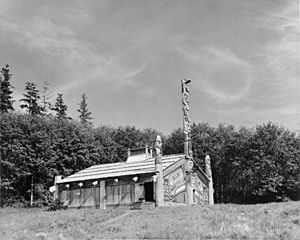Totem Bight State Historical Park facts for kids
Quick facts for kids Totem Bight State Historical Park |
|
|---|---|
 |
|
| Location | Mile 10.5 of the North Tongass Highway, Ketchikan Gateway Borough, Alaska, USA |
| Area | 33 acres (13 ha) |
| Created | 1959 |
| Operated by | Alaska Department of Natural Resources |
|
Totem Bight State Historic Site
|
|
| Nearest city | Ketchikan, Alaska |
| Area | 8.5 acres (3.4 ha) |
| Built | 1940 |
| Architect | Brown, Charles; Et al. |
| NRHP reference No. | 70000916 |
| Added to NRHP | October 27, 1970 |
Totem Bight State Historical Park is a special park in Alaska, a state in the United States. It covers about 33 acres (13 hectares) and is located north of a city called Ketchikan. This park is famous for its amazing collection of totem poles and a replica of a traditional Native chieftain's house.
Contents
What is Totem Bight State Historical Park?
Totem Bight State Historical Park is built on the site of an old Native campground. This place was once known as Mud Village or Mud Bight Village. Today, it's a place where you can learn about the rich history and culture of the Native people of Alaska.
The Community House and Totem Poles
The park features a replica of a traditional chieftain's house. This building is made of wood and has a low, oval entrance. Inside, you'll find a square room with a fire pit in the middle. The house is decorated with carved "house posts" that tell stories. A cool raven design is on the front of the house. A Native carver named Charles Brown from Saxman created these carvings.
The park also has many totem poles. These tall, carved poles are important symbols for Native Alaskan communities. They often tell stories, show family history, or honor important events.
How the Park Was Created
In the 1930s, many Native Alaskans moved to towns for work. They left behind their old villages and the beautiful totem poles there. To save these important cultural items, the United States Forest Service started a project. They used money from the Civilian Conservation Corps (CCC), a program that helped people find jobs during the Great Depression.
Skilled older Native Alaskan carvers were hired for this project. Their job was to fix old totem poles or make new copies of poles from the 1800s. The CCC project also built the community house you see today. They placed 15 totem poles in the park, most of which are replicas. When Alaska became a state in 1959, the land became a state park.
National Recognition
A special part of the park, covering about 8.5 acres (3.4 hectares), is recognized as a historic site. It was added to the National Register of Historic Places on October 27, 1970. This means it's considered a very important place for American history and culture.
See also


